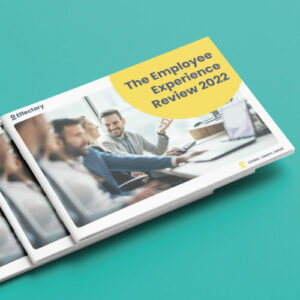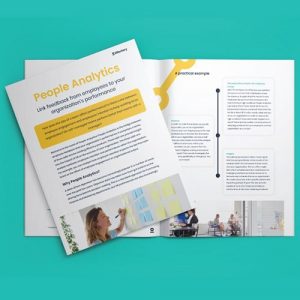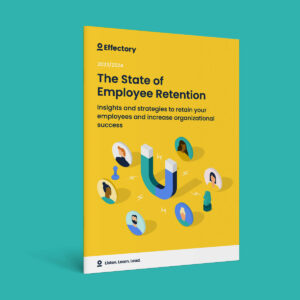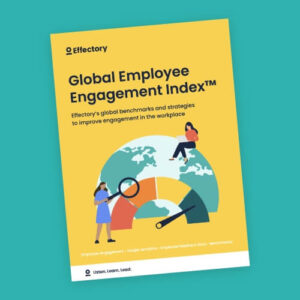Harness the power of HR analytics to improve business performance by learning from these organizations.
People Analytics: 5 Real Case Studies

Data is essential to an organization’s growth and profitability. HR analytics turns the focus inwards on one of the biggest determining factors of a company’s success: their employees. Collect and analyze data about the talent within your organization and get the insights you need to increase productivity, reduce waste, and capitalize on unique opportunities.
As a leading expert in employee feedback solutions, Effectory encourages a data-driven approach to identifying opportunities for improvement within organizations. This includes refining strategies to hire the right talent, designing individual employee development plans, and enhancing employee engagement. We’re always available to talk with you about how we can make people analytics work for your organization.
This article will, first, outline the steps to implementing an effective people analytics strategy and, second, explore case studies from five prominent organizations that highlight the different ways in which HR analytics can be used to improve your business outcomes.
Download the Employee Experience Review
Discover how employees around the world are experiencing different parts of the employee journey and how this affects the employee experience.
DownloadThe steps in an HR analytics strategy
Organizations need to have clearly defined processes to gather data, analyze it, identify patterns, and turn those insights into actionable initiatives. Though the terms are similar, HR reporting and HR analytics are not, in fact, interchangeable. They are actually the first and final steps, respectively, in the three-part process of people analytics.
1. Reporting
HR reporting is the foundation of people analytics, bringing together all the data your organization has tracked.
HR reports are objective and factual. They present data in a digestible way to highlight patterns, but do not derive conclusions.
2. Analysis
HR analysis is the investigative phase where your team draws connections among data points and develops hypotheses.
During analysis, you may need to identify gaps in available data and fill them in using new tools and initiatives like surveys, employee interviews, or game-like personality tests.
3. Analytics
This is where the people-data, HR reports, and analysis come together to give you a definitive picture of the problem or opportunity your organization is facing. Data and hypotheses are structured through analytics to provide actionable insights.
What is predictive people analytics?
Create impact with People Analytics
Link feedback from employees to your organization's performance
DownloadThe following step-by-step guide is another way to map out the people analytics process:
- Identify opportunities or areas for improvement
- Establish performance metrics
- Collect data
- Identify relevant patterns and develop hypotheses
- Fill the data gaps
- Analyze the results
- Implement data-driven strategies
Here are five real-world case studies that demonstrate different ways in which businesses have used people analytics to improve their bottom line.
Johnson & Johnson: Experience and retention
Area for improvement:
American multinational Johnson & Johnson was looking to improve both employee performance and retention. At the time, their recruiters prioritized candidates with job experience in the industry, assuming they were more likely to stay with the company and would be quicker to make significant contributions. As a result, the company experienced a 10 percent decrease in new hires who had recently graduated from college.
The State of Employee Retention
Uncover why employees leave, hidden costs to organizations, and proven retention strategies in our insightful report.
Download
Data and analysis:
Challenging these assumption, HR and the people analytics team at Johnson & Johnson compiled data on 47,000 employees to test the link between experience and turnover. The data revealed that employees hired right out of college actually remained with the organization “significantly longer” than more experienced candidates. Furthermore, there was no significant difference between the two groups’ contributions to the company. Their new hypothesis is that Johnson & Johnson’s two-year leadership development program may help reduce turnover among recent graduates.
Analytics and outcome:
Based on the people analytics, Johnson & Johnson increased hires of new graduates by 20 percent, effectively reducing turnover while maintaining performance.

Clarks: Employee engagement
Area for improvement:
C. & J. Clark is a British shoe manufacturer and retailer with approximately 1400 locations and over 13,000 employees. According to Chief People Officer, Belinda Deery, Clarks already had high levels of employee engagement relative to their industry but were looking to maximize return on investment, especially at the store level.
Data and analysis:
The HR analytics team used 450 data points to get an accurate picture of the relationship between employee engagement and overall business performance. The report and subsequent analysis revealed that for every 1 percent increase in employee engagement, business performance increased by 0.4 percent, confirming the correlation and the value of employee engagement. The analytics team also collected additional data from the company’s 100 best-performing stores.
Analytics and outcome:
The combined findings of this two-step people analytics initiative enabled Clarks to implement multiple effective changes and programs that improved engagement and increased business performance. First, they drafted a replicable schema to create high-performing stores, including the ideal team size for optimum efficiency. The company also designed a store management development program and put together an employee engagement toolkit for managers. The CPO reported positive ongoing results after implementing these initiatives.
Global Employee Engagement Index™
Discover the Global Employee Engagement Index™ 2025 for key insights on driving employee engagement, improving performance, and enhancing team dynamics.
DownloadCredit Suisse: Predicting turnover
Area for improvement:
Credit Suisse is a financial services company based in Switzerland that employs over 47,000 people. To reduce turnover, they tried to predict which employees were most likely to leave the company and when. It’s been estimated that the cost of replacing an employee can be anywhere between 30 and 400 percent of an employee’s salary, depending on seniority and experience. This is a substantial loss for a company the size of Credit Suisse.
Data and analysis:
Because the Credit Suisse workforce is so large and since they have strong data tracking practices, the analytics team had substantial information on who left the company, why, and after how long. The team dug deeper to explore “the specific circumstances prior to the points of departure” by tracking over 40 variables, such as performance ratings, the time spent in a given role, and the size of an employee’s team.
Analytics and outcome:
The resulting predictive people analytics model gave Credit Suisse the ability to accurately predict how likely an employee is to leave the organization in the next year based on as few as ten indicators. With these predictors, Credit Suisse is able to identify risk factors and address these issues with employees before they result in attrition.
Exit
Use the insights of departing employees to uncover hidden truths about your organization and minimize further unnecessary departures.
view solutionE.On: Absenteeism
Area for improvement:
Based in Essen, Germany, E.On is an electric company that employs approximately 78,000 people. When absenteeism rose above the acceptable benchmark set by their HR department, E.On used people analytics to determine the factors driving increased unscheduled time off. Depending on whether an employee is paid hourly or with an annual salary, absenteeism can cost a business anywhere between $2,660 and $3,600 per employee, annually. For an organization of E.On’s size, that potentially adds up to hundreds of millions of dollars.
Data and analysis:
The people analytics team at E.On put together 55 hypotheses. Based on the available data, the team tested 21 hypotheses and finally validated 11 of them. What they found was that the duration and timing of vacation had the biggest impact on the frequency of unplanned time off for the rest of the year. Contrary to popular belief, employees selling back their vacation time to the company did not appear to have any statistically significant impact on absenteeism.
Analytics and outcome:
Based on these insights, E.On implemented policy changes that encouraged managers to be more accommodating with how employees schedule time off. Employees are encouraged to schedule multiple breaks throughout the year with at least one larger vacation—a combination that reduces absenteeism. The findings from this people analytics initiative also provided the HR team with additional insights they can use to test other variables in the future.

Cisco: Choosing an office location
Area for improvement:
This multinational technology conglomerate based out of San Jose, California employs over 75,000 people. When the time came to open a new regional office, the company used people analytics to determine the best building and location for it. The goal was to avoid wasted space, create a positive work environment for employees, and attract the right talent to the organization.
Data and analysis:
With 266 Cisco offices across 87 countries, their People Planning, Analytics and Tools department were able to source data about office usage rates and average costs within the organization. Senior Director Ian Bailie and his team also looked at the building’s neighborhood and the location’s community to evaluate their respective potential impact on business performance. Most importantly, the analytics team explored the availability of talent, specifically from neighboring universities, relative to the number of competitors in the area.
Analytics and outcome:
Because of Bailie and his team’s findings, the company decided to go with a different location than they first had their eye on. Their research found that the original choice would have left the recruitment team struggling to fill the necessary roles. The findings also changed Cisco’s process for opening new offices by bringing people analytics into the discussion much earlier. Planning, staffing, and operating new offices became much more resource efficient.
These are just a few real-world examples of how HR analytics can be used to improve business outcomes. People analytics focuses on an organization’s most valuable resource, its employees, and empowers them to do their best work to benefit the company and its larger goals. Prioritize data and regular reporting to gain meaningful insights and actionable takeaways. Talk to Effectory today to make people analytics a key part of your HR strategy.
Book a free demo. See our solutions in action.
Effectory is Europe's Leading provider of Employee Listening Solutions. Schedule a product demo and discover how to enhance your employees' engagement.
Demo request



